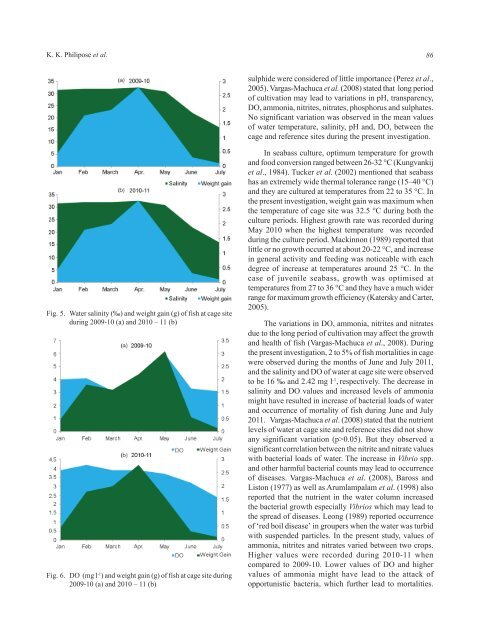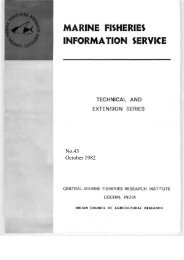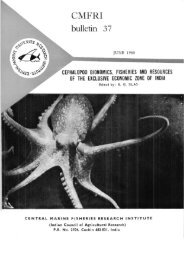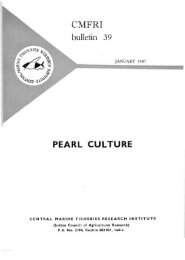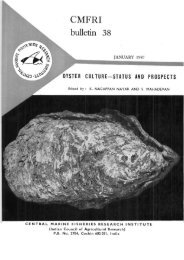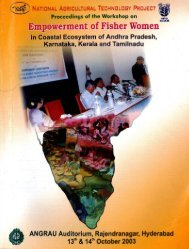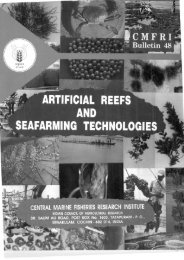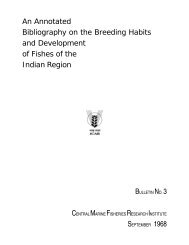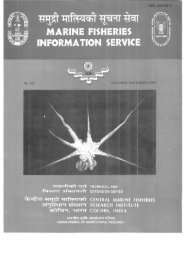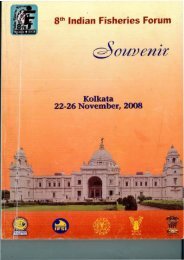IJF Layout 55-1 - Eprints@CMFRI - Central Marine Fisheries ...
IJF Layout 55-1 - Eprints@CMFRI - Central Marine Fisheries ...
IJF Layout 55-1 - Eprints@CMFRI - Central Marine Fisheries ...
You also want an ePaper? Increase the reach of your titles
YUMPU automatically turns print PDFs into web optimized ePapers that Google loves.
K. K. Philipose et al.<br />
86<br />
sulphide were considered of little importance (Perez et al.,<br />
2005). Vargas-Machuca et al. (2008) stated that long period<br />
of cultivation may lead to variations in pH, transparency,<br />
DO, ammonia, nitrites, nitrates, phosphorus and sulphates.<br />
No significant variation was observed in the mean values<br />
of water temperature, salinity, pH and, DO, between the<br />
cage and reference sites during the present investigation.<br />
Fig. 5. Water salinity (‰) and weight gain (g) of fish at cage site<br />
during 2009-10 (a) and 2010 – 11 (b)<br />
Fig. 6. DO (mg l -1 ) and weight gain (g) of fish at cage site during<br />
2009-10 (a) and 2010 – 11 (b)<br />
In seabass culture, optimum temperature for growth<br />
and food conversion ranged between 26-32 °C (Kungvankij<br />
et al., 1984). Tucker et al. (2002) mentioned that seabass<br />
has an extremely wide thermal tolerance range (15–40 °C)<br />
and they are cultured at temperatures from 22 to 35 °C. In<br />
the present investigation, weight gain was maximum when<br />
the temperature of cage site was 32.5 °C during both the<br />
culture periods. Highest growth rate was recorded during<br />
May 2010 when the highest temperature was recorded<br />
during the culture period. Mackinnon (1989) reported that<br />
little or no growth occurred at about 20-22 °C, and increase<br />
in general activity and feeding was noticeable with each<br />
degree of increase at temperatures around 25 °C. In the<br />
case of juvenile seabass, growth was optimised at<br />
temperatures from 27 to 36 °C and they have a much wider<br />
range for maximum growth efficiency (Katersky and Carter,<br />
2005).<br />
The variations in DO, ammonia, nitrites and nitrates<br />
due to the long period of cultivation may affect the growth<br />
and health of fish (Vargas-Machuca et al., 2008). During<br />
the present investigation, 2 to 5% of fish mortalities in cage<br />
were observed during the months of June and July 2011,<br />
and the salinity and DO of water at cage site were observed<br />
to be 16 ‰ and 2.42 mg l -1 , respectively. The decrease in<br />
salinity and DO values and increased levels of ammonia<br />
might have resulted in increase of bacterial loads of water<br />
and occurrence of mortality of fish during June and July<br />
2011. Vargas-Machuca et al. (2008) stated that the nutrient<br />
levels of water at cage site and reference sites did not show<br />
any significant variation (p>0.05). But they observed a<br />
significant correlation between the nitrite and nitrate values<br />
with bacterial loads of water. The increase in Vibrio spp.<br />
and other harmful bacterial counts may lead to occurrence<br />
of diseases. Vargas-Machuca et al. (2008), Baross and<br />
Liston (1977) as well as Arumlampalam et al. (1998) also<br />
reported that the nutrient in the water column increased<br />
the bacterial growth especially Vibrios which may lead to<br />
the spread of diseases. Leong (1989) reported occurrence<br />
of ‘red boil disease’ in groupers when the water was turbid<br />
with suspended particles. In the present study, values of<br />
ammonia, nitrites and nitrates varied between two crops.<br />
Higher values were recorded during 2010-11 when<br />
compared to 2009-10. Lower values of DO and higher<br />
values of ammonia might have lead to the attack of<br />
opportunistic bacteria, which further lead to mortalities.


